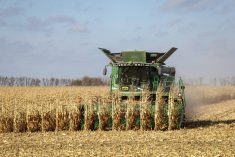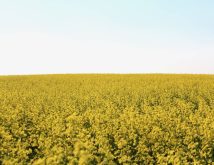Manitoba’s soybean harvest is well underway and yields are expected to be average to above average, depending on how many fields received timely pod-filling rain at the end of July or in early August.
“I’ll say 34, 35 (bushels an acre) right now if I had to put a number on it,” Dennis Lange, Manitoba Agriculture, Food and Rural Development’s (MAFRD) farm production adviser and soybean expert based in Altona said in an interview Sept. 30. “You’ll hear about higher yields out there, but again you need to talk provincial averages, not regional.”
Read Also

Still hard to predict precise fertilizer payback
Despite decades of advances, international research finds no clear answer for where and when adding nutrient will fail to boost growth.
Two days after that interview Statistics Canada estimated Manitoba soybeans would average 35 bushels an acre — two bushels above last year’s average based on crop insurance data and above the five- and 10-year averages of 31 and 29 bushels an acre, respectively. StatsCan’s estimate is based on a survey for farmers taken last month.
The record yield, based on crop insurance data, is 39 bushels an acre set in 2013. Richard Marsh, Syngenta’s technical development lead for the eastern Prairies, said he has his fingers crossed that this year’s provincial average will be closer to 40 bushels an acre than 35.
“Our trial results (on 40-acre fields) last year were between 32 and 52 (bushels an acre) and this year they are anywhere between 38 and 58 (for the same varieties) so it feels like for the most part our yields are going to be closer to 40 than 33 like they were last year,” he said from his office in Brandon.
Marsh believes many, although not all, soybean fields did get timely rains that helped fill their pods.
Whatever the final average yield, 2015 set another record for soybean acreage in the province. While StatsCan estimates almost 1.33 million acres of soybeans were planted in Manitoba, the Manitoba Agricultural Services Corporation’s crop insurance division says almost 1.42 million acres of soybeans were insured, including almost 69,000 acres grown for pedigreed seed. Soybean plantings this year were up 15 per cent from last year.
Besides missing timely rains some soybean fields were hit by hail, Lange said.
“I’m being cautiously optimistic saying yields will be in the mid-30s for an average across the province,” he said. “There could be averages of 45 bushels an acre where they grow longer-season varieties and there have been better growing conditions.”
Combining underway
The soybean harvest in southwest Manitoba was just nicely starting Sept. 30, said Lionel Kaskiw, MAFRD’s farm production adviser in Souris.
“It looks like a good year for the soybeans,” he said.
“There are no real issues regarding harvesting. We had some hail and some of those fields won’t be yielding as good. Disease-wise has been reasonable. I think in the southwest we’re going to have a good harvest for soybeans.”
Kaskiw expects soybean plantings to increase again next year in the southwest, as long as prices remain attractive relative to other crops.
“It helps producers by spreading out the seeding and also spreading out the harvest,” he said. “For most this is the last thing they have left to combine. It spreads things out and lets them farm more acres.”
In the meantime, soybean companies continue to release new, earlier-maturing varieties with higher yield potential.
Soybeans are still relatively new to the region and as a result there have been few pest problems, Kaskiw said.
“I think that’s another reason producers are growing them,” he said.
“I think right now we’re growing them on virgin ground almost. Right now it’s good for the grower and he can take advantage of these years and not have to worry too much about disease issues.
“We’ve been having issues with canola the last few years whether it be spring frosts like we had this year or like a couple of years ago we had flea beetle issues and this spring again.”
Lange also expects Manitoba’s soybean plantings to increase again next year. Eventually pests will emerge, especially where farmers push their rotations, he said.
“We are starting to see more and more phytophthora root rot out in the field and rhizoctonia and there were a few reports of white mould around, but it was fairly minor,” Lange said. “I think though that root rot will be a concern. Rotation can be an issue.”
Asked what his main message to new soybean growers is, Lange replied, “Keep in mind maturity is king. When looking at varieties always pick something suited for your growing region and don’t try to push it too much with longer-season varieties. If you’re growing something out west don’t grow something that does really well in the (Red River) Valley.”
Based on regional soybean yields that’s exactly what farmers have been doing, he added. Yields in the short growing areas of the province are averaging just two to three bushels an acre less than in the longer growing areas, “which tells me growers are picking varieties for their region because they are maximizing their yield potential.”















